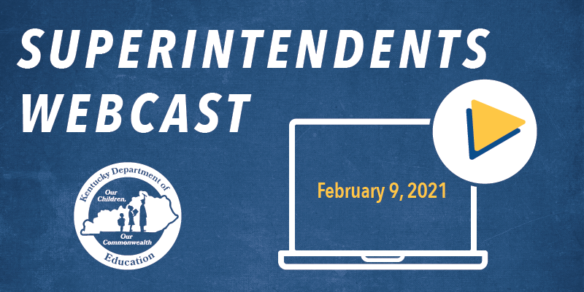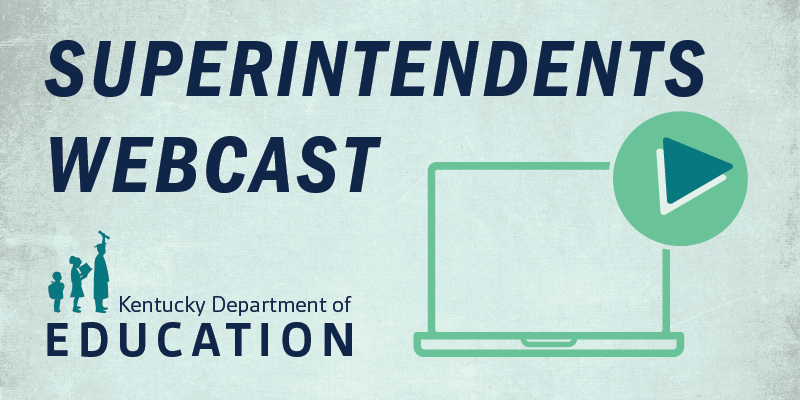
- Even with the rate of vaccinations increasing, no return to normal is expected anytime soon, Commissioner of Education Jason E. Glass said.
- A new round of ESSER II funding is available to Kentucky school districts.
By Jim Gaines
jim.gaines@education.ky.gov
Kentucky Department of Education (KDE) officials explained three new guidance documents related to COVID-19 during the Feb. 9 Superintendents Webcast.
The new guidance was released Feb. 8. Commissioner of Education Jason E. Glass said all COVID-19 guidance will remain in effect for months to come. Even as more Kentuckians are vaccinated, they can’t expect a quick return to normal.
One piece of new guidance details operating schools after staff have been vaccinated. Kelly Foster, associate commissioner in the KDE Office of Continuous Improvement and Support, said schools must keep following five basic expectations outlined in the flagship Healthy at School guidance:
- Social distancing;
- Cloth face coverings, school health policies and personal protective equipment;
- Screening and school exclusion;
- Sanitation and environmental factors; and
- Contact tracing.
School districts must provide an alternative or virtual work for anyone who asks that meets risk criteria for severe complications due to COVID-19, but that requirement ends seven days after the employee has received their final dose of vaccine, Foster said.
“Districts are not required to extend accommodations to employees who refuse to take the vaccine,” she said.
Accommodations required under the Americans with Disabilities Act and Section 504 of the Rehabilitation Act remain in force, Foster said.
Even after someone is vaccinated, if they’re exposed to COVID-19 that person is expected to follow existing quarantine rules, Foster said.
Dr. Connie White, deputy commissioner of the Kentucky Department for Public Health (DPH), said the currently available vaccines are very effective at preventing serious illness from COVID-19, but it’s possible that people who have been vaccinated still can carry the disease and unknowingly infect others.
White reiterated the message Gov. Andy Beshear gave during his media briefing Feb. 8: COVID-19 deaths remain high in Kentucky but all other trends are positive. New cases are declining steadily, positive test rates are lower, fewer people are hospitalized, there are fewer cases in nursing homes and the number of vaccinations being given is increasing.
ESSER Funding
A new round of Elementary and Secondary School Emergency Relief (ESSER) funding is available through the Coronavirus Response and Relief Supplemental Appropriations Act (CRRSA). KDE issued guidance on Feb. 8 about using ESSER II funding.
The new money can be used for expenses going back to March 13, 2020, when Kentucky’s pandemic emergency was declared, said Robin Kinney, associate commissioner in the KDE Office of Finance and Operations. It can pay for expenses obligated up to Sept. 30, 2023.
The purpose of the $928 million in new ESSER II funding is to help prevent COVID-19 outbreaks and prepare for responding to them, but with added emphasis on providing services directly to students. A list of permissible uses is included on pages 4 and 5 of the guidance, Kinney said. The spending needs to be tracked separately from ESSER I funds, she said.
An FAQ sheet on using the new funds will be posted soon, Kinney said. To add questions to the ESSER II and GEER II funding FAQ, email covid19@education.ky.gov.
Another webcast for superintendents will be held Feb. 23, Glass said. At that meeting he wants to discuss plans to use the new round of ESSER II funding, so he asked superintendents to seek ideas from students and their communities.
The state has set aside $92.8 million from ESSER II for use by the Kentucky School for the Deaf, Kentucky School for the Blind, area technology centers and statewide projects, Kinney said. But local school districts also have a chance to access some of that money, she said. It will be allocated on a per-pupil basis among the school districts that meet criteria for its use.
Preliminary rules for accessing the set-aside money say districts must spend 85% of their allocated district ESSER II funds on direct services to support students; and by April 1 begin offering 12 or more hours per week of in-person instruction. The goal is for districts to get a minimum of $75 per student, Kinney said.
The requirements for fund use and tracking are similar to those for districts used for ESSER II funds, she said.
Promotion and Retention
The third new guidance document deals with decisions regarding promotion and retention.
The Kentucky Multi-Tiered System of Supports (KyMTSS) framework helps schools identify early students who are chronically absent or at risk. Risks of absenteeism increase during distance learning, said Micki Ray, director of the KDE Division of Program Standards.
Targeted interventions may be needed in the spring to accelerate student learning, she said.
Districts should analyze student data to find the root causes of absenteeism and identify barriers to attendance or learning, then implement and monitor tiered interventions before holding any student back.
ESSER II funds can be used to support students who need accelerated learning. Districts should also consider what support students may need in fall 2021, according to the guidance.
Many resources for promotion and retention decision-making can be found on the KYStandards webpage. More can be found on a KDE page for support and implementation of MTSS.
Commissioner’s Listening Tour
Glass will hold nine sessions of a listening tour around the state from April 6 to May 6 to gather input on long-term aspirations for Kentucky’s educational system. The 90-minute sessions will focus in turn on each cooperative region and Louisville, but all the sessions will be virtual, so people can join any of them.
Participants can pre-register online for the Commissioner’s Listening Tour.
All sessions will start at 6 p.m., local time. More information will be released soon. Tentatively, the schedule is as follows:
- April 6: Greater Louisville Educational Cooperative
- April 8: West Kentucky Educational Cooperative (Murray)
- April 15: Green River Regional Educational Cooperative (Bowling Green)
- April 20: Southeast/South-Central Educational Cooperative (Richmond)
- April 22: Central Kentucky Educational Cooperative (Lexington)
- April 27: Northern Kentucky Cooperative for Education Services (Cold Springs)
- April 29: Ohio Valley Educational Cooperative (Shelbyville)
- May 4: Kentucky Valley Educational Cooperative (Hazard)
- May 6: Kentucky Educational Development Cooperative (Ashland)




Leave A Comment